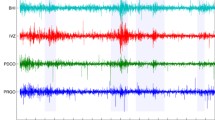Abstract
Financial markets are a classical example of complex systems as they are compound by many interacting stocks. As such, we can obtain a surprisingly good description of their structure by making the rough simplification of binary daily returns. Spin glass models have been applied and gave some valuable results but at the price of restrictive assumptions on the market dynamics or they are agent-based models with rules designed in order to recover some empirical behaviors. Here we show that the pairwise model is actually a statistically consistent model with the observed first and second moments of the stocks orientation without making such restrictive assumptions. This is done with an approach only based on empirical data of price returns. Our data analysis of six major indices suggests that the actual interaction structure may be thought as an Ising model on a complex network with interaction strengths scaling as the inverse of the system size. This has potentially important implications since many properties of such a model are already known and some techniques of the spin glass theory can be straightforwardly applied. Typical behaviors, as multiple equilibria or metastable states, different characteristic time scales, spatial patterns, order-disorder, could find an explanation in this picture.
Similar content being viewed by others
References
E. Schneidman, M.J. Berry, R. Segev, W. Bialek, Nature 440, 1007 (2006)
T. Dal’Maso Peron, F. Rodrigues, Europhys. Lett. 96, 48004 (2011)
L. Sandoval, I. Franca, Physica A 391, 187 (2012)
L. Laloux, P. Cizeau, J. Bouchaud, M. Potters, Phys. Rev. Lett. 83, 1467 (1999)
R. Mantegna, Eur. Phys. J. B 11, 193 (1999)
J. Onnela, A. Chakraborti, K. Kaski, J. Kertesz, Physica A 324, 247 (2003)
P.E. Vértes, R.M. Nicol, S. Chapman, N. Watkins, D.A. Robertson, E.T. Bullmore, Front. Syst. Neurosci. 5 (2011)
B. Rosenow, P. Gopikrishnan, V. Plerou, H. Stanley, Physica A 314, 762 (2002)
S. Bornholdt, Int. J. Mod. Phys. C 12, 667 (2001)
W. Zhou, D. Sornette, Eur. Phys. J. B 55, 175 (2007)
D. Sherrington, Physica A 384, 128 (2007)
W.A. Brock, S.N. Durlauf, Rev. Econ. Stud. 68, 235 (2001)
A. Mas-Colell, M. Whinston, J. Green, U.P.F.F. de Cičncies Econňmiques i Empresarials, Microeconomic theory (Oxford University Press, New York, 1995), Vol. 1
E. Jaynes, Phys. Rev. 106, 620 (1957)
R. Kubo, J. Phys. Soc. Jpn 17, 1100 (1962)
T. Plefka, J. Phys. A 15, 1971 (1982)
D. Barber, P. van de Laar, Journal of Artificial Intelligence Research 10, 435 (1999)
E. Schneidman, S. Still, M.J. Berry, W. Bialek, Phys. Rev. Lett. 91, 238701 (2003)
M. Aoki, New Approaches to Macroeconomic Modeling: Evolutionary Stochastic Dynamics, Multiple Equilibria, and Externalities as Field Effects (Cambridge University Press, Cambridge, 1998)
K.H. Fischer, J.A. Hertz, Spin Glasses (Cambridge University Press, Cambridge, 1991)
R. Kindermann, J. Snell, in Markov Random Fields and Their Applications, edited by American Mathematical Society (American Mathematical Society Providence, Rhode Island, 1980)
Y. Roudi, J. Tyrcha, J. Hertz, Phys. Rev. E 79, 051915 (2009)
S. Dorogovtsev, A. Goltsev, J. Mendes, Rev. Mod. Phys. 80, 1275 (2008)
M. Carmeli, J. Stat. Phys. 10, 259 (1974)
K. Binder, A. Young, Rev. Mod. Phys. 58, 801 (1986)
Author information
Authors and Affiliations
Corresponding author
Rights and permissions
About this article
Cite this article
Bury, T. Statistical pairwise interaction model of stock market. Eur. Phys. J. B 86, 89 (2013). https://doi.org/10.1140/epjb/e2013-30598-1
Received:
Revised:
Published:
DOI: https://doi.org/10.1140/epjb/e2013-30598-1




